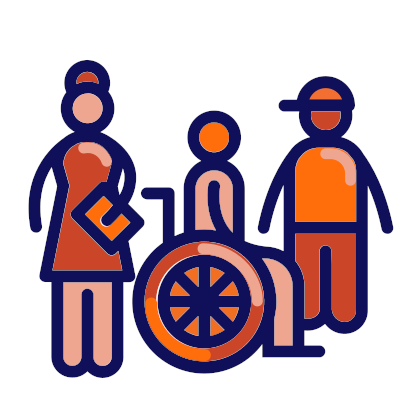Preventing bullying and violence

Schools can, and should, play a key role in tackling these abuses.
Whole-school anti-bullying programmes are needed, which promote peer support systems and involve active and well-trained teachers and parents, to foster a safe learning environment in which no violence is allowed.
Facts & figures
Half of the world’s students aged 13-15 say they have experienced violence in and around school.[1]
Nearly one in three students of this age say they have experienced bullying or been involved in fights.[2]
More than 700 million children have no legal protection from corporal punishment at school.[3]
What is violence and bullying?
Violence is the threatened or actual use of physical force or power resulting in physical or psychological harm to others.
Bullying is a form of violence. It can be defined as unwanted, aggressive behaviour which involves a real or perceived imbalance of power. It is behaviour that is repeated, or carries the threat of being repeated over time.
Bullying takes different forms in school, including:
- Physical, e.g., hitting, kicking, slapping, shoving, hair-pulling, etc.
- Verbal, e.g., name-calling, teasing, using belittling expressions, etc.
- Relational, e.g., ostracising, spreading rumours, social manipulation, etc.
- Sexual, e.g., sexual name-calling, uninvited touching, propositioning, etc.
Cyberbullying is a distinctive form of bullying. It differs from other types on account of the constant risk of public exposure, the complex roles of observers and the size of the audience that comes with digital technologies.[4].
Bullying is not the only form of student-on-student violence in schools, however. Fights between, and attacks on students associated with gang culture and the carrying of weapons, especially knives, are becoming an increasing problem in various countries.
Why is addressing violence and bullying important at school?
Under the U.N. Convention on the Rights of the Child, schools have a formal duty to protect children from all forms of violence, both physical and psychological.
“Parties shall take all appropriate legislative, administrative, social and educational measures to protect the child from all forms of physical or mental violence, injury or abuse, neglect or negligent treatment, maltreatment or exploitation, including sexual abuse, while in the care of parent(s), legal guardian(s) or any other person who has the care of the child.”[5]
Failure to protect children at school can have harmful repercussions on their future lives, both educationally and socially - whether they be victims, perpetrators or bystanders.
Students who are bullied are more likely to suffer from depression and anxiety, health issues, poor academic achievement and behaviour problems at school, including higher drop-out rates. A small number may also retaliate in violent ways. Students who bully others are more likely to exhibit other behaviour problems at school and to suffer from alcohol or drug abuse, and to engage in criminal activity and abusive relationships in adulthood. Children who witness bullying and violence are also more likely to have mental health difficulties and miss or drop out from school.
Violence and bullying not only affects academic learning, it also impacts negatively on the social development of young people. In particular, students who experience violence and bullying are more likely to have difficulty developing basic democratic competences, such as empathy, respect for others, openness to other cultures and beliefs, tolerance of ambiguity and self-efficacy – all of which lie at the heart of the Council of Europe Reference Framework of Competences for Democratic Culture.
The effects of violence and bullying are not limited only to the students directly involved, but potentially impact on everyone at a school. Unchecked, incidents of violence and bullying lead to an atmosphere of anxiety and insecurity incompatible with learning. They also lead to, or exacerbate conflicts beyond the school gates, which in turn have further consequences for relations within the school.
What are the challenges?
Violence and bullying can be challenging to deal with at school. What is regarded as bullying or violence is sometimes thought of as a matter of subjective opinion. It can be difficult to build a common approach to eradicating from school something which a significant proportion of staff believes not to exist or is not important to them.
The prevailing culture in a school can sometimes work against attempts to reduce violence in its different forms. Rule by fear, over-emphasis on punishment and the prioritization of learning environments which support competitive behaviour all militate against the prevention of violence and bullying. So, too, does the holding of an ideology which accepts violence as a valid response in situations of fear, stress or frustration – as evidenced in the advice commonly given to victims of bullying to fight back and give the bully a ‘taste of their own medicine.’
In such circumstances it can be easy to think that dealing with violence and bullying is simply a matter of stopping fights, giving punishments and imposing order, rather than questioning the wider culture of the school, the examples it sets and the sorts of behaviour it supports.
Many teachers are unaware of democratic approaches of dealing with violence and bullying, such as:
- restorative justice
- conflict resolution
- peer mediation.
Such approaches are not only arguably more effective than punitive ones, but also have the advantage of promoting democratic values and attitudes more widely across a school.
Such approaches take time to learn, however, and require the development of specific types of skills, knowledge and attitudes. They also take time to put into practice. It can be difficult for a teacher to find the time and motivation to deal with violence and bullying in a democratic and constructive way. It is easier just to punish the supposed perpetrator, and easier still to pass the perpetrator up the school hierarchy for a more senior member of staff to punish.
A further challenge in recent years has been the rise of gang culture among young people and the carrying of weapons, especially knives, in as well as out of school. This has led to a rise in the number of serious acts of violence between students and also to the more regular involvement of the police in school affairs, both of which demand new professional skills and ways of working from teachers and school leaders.
How can schools get active?
Taking action on violence and bullying is not just a matter of finding better ways of responding to incidents after they have occurred – though this is important, but also of creating the kind of school environment in which violent incidents are less likely to happen in the first place.
A good place to start is with asking students to review the current situation in their school:
- where they feel vulnerable or in danger
- where they feel safe
- what sorts of violence they have witnessed or experienced
- what they see as the causes of these sorts of violence
- how effective they think the school is at dealing with violence
- what further measures they would like the school to take.
Surveying student opinion provides a good evidence base for targeting measures to prevent violence, e.g., increasing supervision in areas in school where students are fearful of going, creating more opportunities for constructive play during breaks from lessons, etc.
It can also stimulate a whole-school conversation about violence and bullying. Such a conversation is important for arriving at a whole-school policy that everyone can support. It is an opportunity to develop a common language and understanding of what constitutes violence and bullying in school and shared rules on how to approach it, including the reporting and monitoring of incidents. This is why it is essential that the voices of all school stakeholders are heard in the process of policy-development: principals, teachers, students, parents and the local community.
The conversation should also include the opportunity for teachers to reflect on practices that lead to frustration and low self-esteem among students, such as an over-emphasis on competition, over-frequent assessment and unreasonably high expectations of academic attainment. Attention should be given instead to creating a school environment which encourages inclusion and co-operation, and the valuing of individual differences and diversity.
Reflection on current practice goes hand in hand with the provision of opportunities for school staff to develop new skills. The ability to recognise violence in all its forms and to be able to deal with it appropriately are important professional skills for any adult involved in school life.
As young people themselves are often the most effective agents for change in a school, it is important they should be involved in formal initiatives to reduce violence and bullying, such as peer mediation schemes. Such schemes are most effective when taken seriously by both staff and the students involved, for example, by instituting formal recruitment procedures for student mediators and opportunities for high-level training from someone with the appropriate professional expertise.
Initiatives of this kind can be supported in the classroom by making time in the curriculum to talk with students about issues of violence and bullying. It should include discussions about the psychology of bullying, the effects of peer pressure and the influence of social media on young people’s behaviour.
[1] UNICEF Report, September 2018
[4] de Morais & Fernandes, 2017. ‘When bullying crossleakes the screen’. In J. Richardson, E. Milovidov & R. Blamire (Eds.), Bullying: Perspectives, Practices and Insights (pp. 11-16). Strasbourg, France: Council of Europe.
 Resources on Preventing violence and bullying
Resources on Preventing violence and bullying
 Related schools projects
Related schools projects
Address:
Country: England, United Kingdom
Project: Embedding Whole-School Student Voice
 Working language during the project:
Working language during the project:
- English
 Themes of the Council of Europe campaign “FREE to SPEAK, SAFE to LEARN - Democratic Schools for All” covered:
Themes of the Council of Europe campaign “FREE to SPEAK, SAFE to LEARN - Democratic Schools for All” covered:
- Making children’s and students’ voices heard
- Addressing controversial issues
- Preventing violence and bullying
- Dealing with propaganda, misinformation and fake news
- Tackling discrimination
- Improving well-being at school
 Competences from the Reference Framework of Competences for Democratic Culture (CDC) addressed and where / how they were integrated:
Competences from the Reference Framework of Competences for Democratic Culture (CDC) addressed and where / how they were integrated:
- Respect
At the heart of this project is the value of respect for self, respect for others and respect for education. Through the project we will establish a clear set of respect protocols to ensure that all students are able to fully participate and contribute to discussions in a safe and respectful environment. - Valuing human dignity and human rights
Teaching of Human Rights education through our Citizenship, PSHCE and Holistic Curriculum will form an essential basis of this project. - Empathy
All students will have a series of taught and skills development sessions on the value of empathy and how to develop it. These will consist of assemblies, taught sessions through the PSHCE curriculum and key workshops.
 Target group age range:
Target group age range:
- 11-15
- 15-19
 Level of education:
Level of education:
- Lower secondary education
- Upper secondary education
Short description of the project:
This project aims to build a fully democratic and inclusive school where all students are represented in democratic processes and have a voice in shaping the ethos and principles of the school. This will incorporate student representation at Local Governing Body and Leadership level, in policy review processes and through Student Leadership and School Council activities. Staff and students will work together to establish the core principles of our democratic school and these will be clearly communicated, both internally and externally, as fundamental to the school’s ethos. An Equality and Diversity Group will be established and will meet six times per year. This will be an open access group where all students within the school community have an opportunity to fully participate.
A number of key events will be established and delivered on an annual basis. These will include:
- A Question Time event where students will form part of the panel alongside Members of the British Parliament.
- The school will establish ongoing debating activity and discussion groups and will commit to entering teams in Debating and Mock Trial events.
- Linking activities such as ‘Carry My Story’ and the ‘Journeys Project’ where students are able to connect to community organisations and to other schools in order to develop their knowledge and understanding of the world.
All students in the school will also participate in a ‘mock General Election’ event to coincide with the UK General Election on 12th December. This will include delivery of taught lessons for all students on the democratic process and the UK electoral system. All students will have an opportunity to discuss and debate the policies of the different parties and will participate in a voting exercise on Election Day.
In addition, our Environmental Action Group of students will continue to run their campaign and we will commit to supporting and facilitating this wherever possible. We will also help to empower a number of other nascent student action groups including ‘Votes at 16’ and ‘Women and Leadership’.
We will work with a number of key partners to support this work and to enable our students to engage at a local, regional, national and international level. These will include six Universities, The British Council, The UK in a Changing Europe, Young Citizens, NECE and any other organisations who are willing to engage with our young people and add value to our work.
A steering group will be established to drive this agenda forward – this will consist of Student Representatives, Governor Representatives, members of the School Leadership Team and key members of staff.
 Aims/objectives
Aims/objectives
- To embed student representation at all levels of decision making.
- To empower students to have a sense of ownership of their school and to enable all students to make a contribution to the current and future direction of the school.
- To enable all students to feel included, safe and respected within the school community.
- To enhance our students understanding of local, regional, national and global contexts, debates and issues.
- To ensure that all our students have a voice and are confident that they are able to make a contribution.
 Expected results/outcomes
Expected results/outcomes
We would anticipate that our students feel increasingly empower and engaged and have a greater sense of autonomy and ownership over their capacity to learn, engage and change. We would also expect that all our students feel that they have improved their knowledge and awareness of political and democratic processes in the UK. We will collect data at the start and end point to ascertain whether we have established a culture change through this initiative.
 Changes
Changes
As outlined above, increased structural and systematic representation of student voices.
 Challenges you faced
Challenges you faced
This is a major, whole-school initiative which will require energy and commitment from all stakeholders. We will also need to have a clear communication strategy which includes all members of our school community, parents and families and a number of key external partners.
 Time-frame of the project:
Time-frame of the project:
- November 2019 to July 2021
 Council of Europe materials on citizenship and human rights education used while preparing or implementing your practice:
Council of Europe materials on citizenship and human rights education used while preparing or implementing your practice:
- Reference Framework of Competences for Democratic Culture
- Living Democracy - manuals for teachers
- Democratic governance of schools
- Addressing violence in schools through EDC/HRE
- All Different – All Equal
- Managing controversy
- Teaching controversial issues-training pack
- Human Rights and Democracy Start with Us – Charter for All
- How all Teachers Can Support EDC/HRE: A Framework for the Development of Competences







